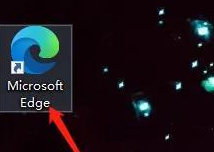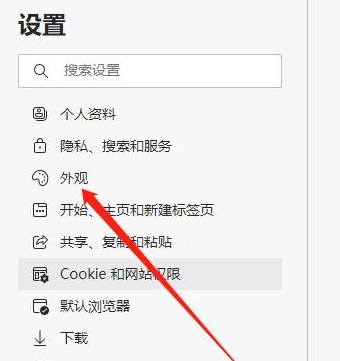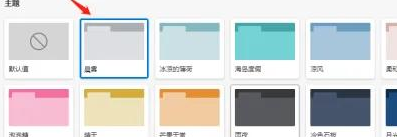 Software Tutorial
Software Tutorial
 Computer Software
Computer Software
 How to set the theme of Microsoft Edge browser-How to set the theme of Microsoft Edge browser
How to set the theme of Microsoft Edge browser-How to set the theme of Microsoft Edge browser
How to set the theme of Microsoft Edge browser-How to set the theme of Microsoft Edge browser
php editor Xinyi introduces you to the theme setting method of Microsoft Edge browser. By setting themes, you can personalize the browser interface and improve user experience. This article will explain in detail how to set a theme in the Microsoft Edge browser to give your browser interface a completely new look.
Find the Microsoft Edge browser and double-click it to open it.

Double-click [Settings] to open the setting interface.

Again, open the [Appearance] interface

To set the theme, open the appearance interface on the right side and select the appropriate theme color.

The above is the detailed content of How to set the theme of Microsoft Edge browser-How to set the theme of Microsoft Edge browser. For more information, please follow other related articles on the PHP Chinese website!

Hot AI Tools

Undresser.AI Undress
AI-powered app for creating realistic nude photos

AI Clothes Remover
Online AI tool for removing clothes from photos.

Undress AI Tool
Undress images for free

Clothoff.io
AI clothes remover

Video Face Swap
Swap faces in any video effortlessly with our completely free AI face swap tool!

Hot Article

Hot Tools

Notepad++7.3.1
Easy-to-use and free code editor

SublimeText3 Chinese version
Chinese version, very easy to use

Zend Studio 13.0.1
Powerful PHP integrated development environment

Dreamweaver CS6
Visual web development tools

SublimeText3 Mac version
God-level code editing software (SublimeText3)

Hot Topics
 How to set up microsoft edge autofill_microsoft edge autofill setting tutorial
May 09, 2024 pm 01:22 PM
How to set up microsoft edge autofill_microsoft edge autofill setting tutorial
May 09, 2024 pm 01:22 PM
1. First open Microsoft Edge, click the [...] button, and then click the [Settings] option button. 2. Then click the [Password and Autofill] button. 3. The last step is the Microsoft Edge auto-fill setting area.
 How to enable microphone permission in Edge browser How to enable microphone permission
May 09, 2024 pm 04:40 PM
How to enable microphone permission in Edge browser How to enable microphone permission
May 09, 2024 pm 04:40 PM
1. First, click Start, right-click and select [Microsoft Edge]. 2. Then, click [More] to open [App Settings]. 3. Next, find and enter [Application Permissions]. 4. Then, find [Microphone] in the permissions below. 5. Finally, turn on the switch behind the microphone.
 What to do if there is no sound in Edge browser What to do if there is no sound in Edge browser
May 09, 2024 pm 12:30 PM
What to do if there is no sound in Edge browser What to do if there is no sound in Edge browser
May 09, 2024 pm 12:30 PM
1. First, right-click the volume in the lower right corner and click [Open Volume Mix]. 2. Then, click the small speaker under the speaker to turn it off. 3. Again, click on the small speaker to open it, and then restart the computer. Solution 2: 1. First, right-click the volume in the lower right corner and click [Playback Device]. 2. Then, right-click the device in the list in the interface and [Disable] all devices. 3. After that, enable the applications one by one, click [OK] to restart the computer.
 How to reset Microsoft Edge browser_Microsoft Edge browser reset tutorial
May 09, 2024 pm 02:19 PM
How to reset Microsoft Edge browser_Microsoft Edge browser reset tutorial
May 09, 2024 pm 02:19 PM
Step 1: Open the Microsoft Edge browser (as shown in the picture). Step 2: Click the three-dot icon in the upper right corner of the browser window (as shown in the picture). Step 3: In the drop-down menu that appears, select Settings (as shown in the picture). Step 4: Then click Reset Settings (as shown in the picture). Step 5: Under [Reset Settings], click to restore the settings to their default values (as shown in the picture). Step 6: When prompted, click the [Reset] button (as shown in the picture).
 How to create a shortcut in the Microsoft Edge browser_How to create a shortcut in the Microsoft Edge browser
May 09, 2024 am 11:58 AM
How to create a shortcut in the Microsoft Edge browser_How to create a shortcut in the Microsoft Edge browser
May 09, 2024 am 11:58 AM
Step 1: First, right-click an empty space on the desktop, and in the pop-up window, click [New Shortcut], as shown in the figure. Step 2: In the input box, enter [%windir%explorer.exeshell:::{4234d49b-0245-4df3-b780-3893943456e1}] and click Next, as shown in the figure. Step 3: Just click [Finish], as shown in the picture. Step 4: A folder icon named [explorer.exe] appears on the desktop, as shown in the figure. Step 5: Double-click this folder, and after opening it, you will find that the browser icon is white, as shown in the picture. Step 6: Right-click the icon, and in the pop-up option box, click
 How to add extensions to Microsoft Edge browser How to add extensions to Microsoft Edge browser
May 09, 2024 am 11:10 AM
How to add extensions to Microsoft Edge browser How to add extensions to Microsoft Edge browser
May 09, 2024 am 11:10 AM
The first step is to click on the Start menu, find Microsoft Edge, and open it. In the second step, click on the Edge browser, three dots in the upper right corner, and [Extensions]. The third step is to search in the search box or click [Get Microsoft Edge extension]. The fourth step is to find the extension plug-in you want to add and click the plug-in icon. Step 5: The next interface pops up and click [Get]. Step 6: When the interface pops up, click [Add Extension]. The seventh step is to add the extension plug-in.
 How to set up media auto-play in Edge browser. Specific steps to set up media auto-play.
May 09, 2024 pm 12:40 PM
How to set up media auto-play in Edge browser. Specific steps to set up media auto-play.
May 09, 2024 pm 12:40 PM
1. First, open Microsoft Edge, click the […] button, and click the [Settings] option button with the mouse. 2. Then, click the [Advanced] button on the left. 3. Finally, the arrow points to the Microsoft Edge media autoplay menu button.
 How to solve the problem that the web page pops up automatically when the Microsoft Edge browser starts up_How to solve the problem when the web page pops up automatically when the Microsoft Edge browser starts up
May 09, 2024 pm 04:10 PM
How to solve the problem that the web page pops up automatically when the Microsoft Edge browser starts up_How to solve the problem when the web page pops up automatically when the Microsoft Edge browser starts up
May 09, 2024 pm 04:10 PM
1. Click to open the edge browser, left-click the three-dot icon in the upper right corner, and then select the [Settings] option to enter, as shown in the figure below. 2. After entering the page, click [Cookies and Website Permissions] in the left navigation bar to open it, as shown in the figure below. 3. Then, we slide the mouse wheel to the page on the right, find the [Pop-up windows and redirection] option and click to enter, as shown in the figure below. 4. After entering, we click the [Switch] button behind the [Block] function to turn it on, as shown in the figure below. 5. In addition, we can also click the [Add] button after [Block], and then add the URLs that do not allow pop-up windows to the box, then the URL-related information we add will not





